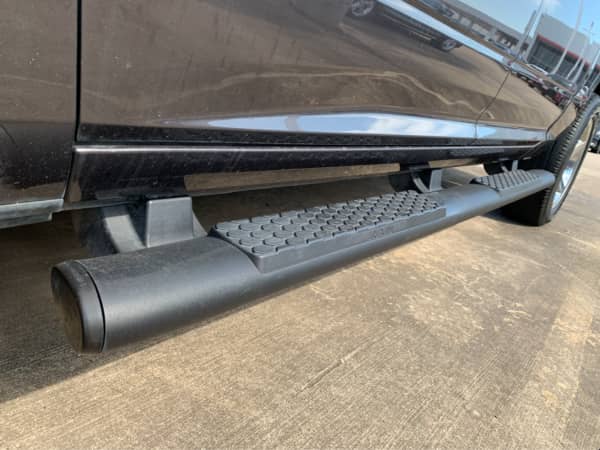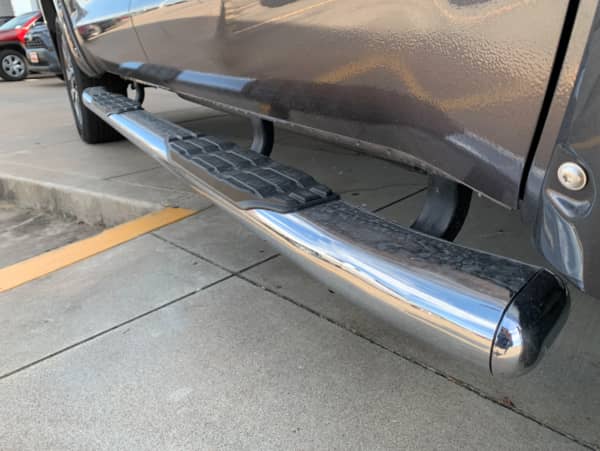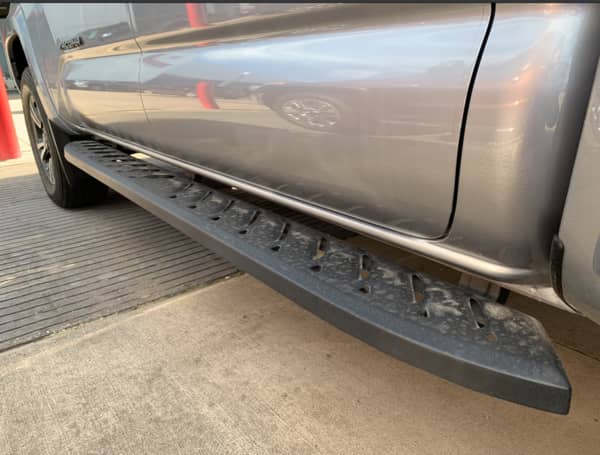Whether they came on the truck from the factory or if they were installed aftermarket, nearly every truck you’ll see on the road today has some form of a step installed below the doors. Most commonly, this step will either be a nerf bar, a side step, or a running board. For vehicle owners who are considering adding a step to the side of their truck, being able to tell one of these options from the other can be confusing, as can weighing the pros and cons of each. Each alternative is unique, and it’s important to know how to make the best choice for your truck.
What are the differences between nerf bars, side steps, and running boards? The primary difference between the three is aesthetic; most people decide on which they prefer based on looks. However, there are functional differences in the following categories as well:
- Durability
- Practicality
- Ability to protect the truck from road debris
While the primary differentiator between nerf bars, running boards, and side steps are cosmetic, there are many differences between the three options that can affect their functionality, and thus their fit for your particular truck. With that being said, let’s go over why truck owners install any of these options in the first place and then get into the differences between each.

Why Install Nerf Bars, Running Boards, or Side Steps?
There are several reasons that truck owners choose to install a step of some form on their truck. Being familiar with all of them is important in making sure that you pick the right one for your vehicle. So, why do people want nerf bars, running boards, or side steps?
- They make it easier to get into your truck. The most obvious and most common reason people install a step on their vehicle is to make it easier to get into and out of it. Trucks are, of course, quite a bit higher than cars and most crossovers and SUVs, and this can make it more difficult for some drivers to enter and exit their vehicles. Installing a step of any kind can make this process substantially more accessible by giving those drivers who need it a place to put their foot as they lift themselves into their trucks. This benefit becomes even more pronounced for lifted trucks, which can be challenging to get into for even the spriest and most able-bodied drivers.
- They look good. Another primary reason that people choose to install a step on their truck is the cosmetic enhancement that it offers. All three options can be effective in making the vehicle look a bit more rugged or a bit more streamlined, depending on the style that you go for. Additionally—and this is especially true of lifted vehicles—installing a step makes the truck appear more imposing, as on-lookers will immediately assume that the requirements of a step to enter the vehicle means that it is very high off the ground, even if your lift is actually modest.
- They give you a place to wipe your feet. Trucks are utilitarian vehicles, often used on job sites, or for hunting or other outdoor activities where one’s shoes can collect quite a bit of mud and dirt. Without a step, mud and dirt is easily tracked into the truck, ruining the carpets and floormats, and generally making the vehicle look a lot more worn than it actually may be. However, having a step installed gives people entering the truck with dirty shoes a place to wipe that mud or dirt off, protecting the interior.
- They protect the truck from road debris. This applies only to running boards and nerf bars, but it is important to mention, nonetheless. The installation of either of these two step options can help protect the side of the truck from road debris and thus paint chips. Because of the step’s location alongside the bottom edge of the truck’s cab, installing them can prevent the front tires from kicking up rocks and debris that would, without a step to block them, hit the paint and potentially damage it. This can go a long way in preserving the condition of your truck’s factory paint, which can be a huge cost-saver for those looking to keep their vehicle for the long-haul.
- They protect the truck when off-roading. Another significant benefit of installing some sort of step on the side of the vehicle is that they can help protect the body of the truck from being damaged while off-roading. They do this by guarding the lower part of the cab against being impacted by larger rocks that the vehicle may be driving over. While the steps themselves can get damaged from this, they are much easier and much less expensive to replace than a door or rocker panel.
The above-listed benefits are, with that one exception regarding the road debris protection, applicable to nerf bars, running boards, and side steps alike. Now, with those out of the way, let’s get into the differences between each option, and discuss which of the three is better at providing specific benefits.
Nerf Bars
Nerf bars are round or oval-shaped tubes that extend along the bottom side of the truck’s doors. Nerf bars will have a flattened section that is often lined in rubber or plastic, giving people entering and exiting the vehicle a solid surface upon which they can step.
Nerf bars are one of the most common step options for truck owners, and they actually come with an interesting racing history, too! According to Magnum Trucks, nerf bars have origins in racing, as they were used to protect cars from minor contact with other cars while racing. This is where nerf bars get their name: they were used to “nerf” or soften the impact of other vehicles that racers may have accidentally (or perhaps intentionally) bumped into.
The history of their naming aside, nerf bars are one of the most popular options out there, and for good reason: they look great, and they are also the most all-around functional as well as durable of the three options that we have been discussing.

Their functionality advantage is a result of their more substantial construction, as they are typically made of a durable metal that is both physically strong and coated in a finish that is resistant to corrosion and rust. Additionally, their tubular design makes them the most effective option when it comes to rock-sliding and similar off-road protections. They also do an excellent job of protecting the side of the truck from rocks kicked up by the front tires.
However, nerf bars are not the end-all-be-all, clear winner here, as they do have some downsides. Primarily, they are actually the least effective when it comes to providing an easy and stable stepping surface. Because of their shape, nerf bars don’t offer too much surface area to step on, so for people who struggle with balance and need that extra surface area, nerf bars may not be the best option.
To sum up nerf bars:
Pros
- Durable
- Good protection against road debris
- Great protection against rocks while off-roading
- Rugged look
Cons
- Not the greatest stepping surface
Running Boards
Running boards are a completely flat board that extends alongside the bottom portion of the truck’s cab, underneath the doors.
Running boards are another very common option for truck owners, and they offer a great all-around solution for people who want a step on the side of their truck. This is why they are the option that most OEM truck manufacturers choose to offer on their trucks: they are an unoffensive looking, and well-rounded option.
Additionally, some OEM and aftermarket options come with the ability to retract underneath the cab when not in use, which can be a neat feature to have. Still, these setups are very expensive, costing more than $1,000 in most cases.

Running boards are great at offering protection from road debris, as their completely flat design gives them a bit more surface area, and thus slightly more area that rocks and debris will be prevented from passing by. However, running boards are not effective in protecting the truck from rocks, or in acting as rock-sliders, while off-roading.
Because of the way that they are designed, running boards are not very robust, in that, if they were to be impacted by a rock, they would not hold up nearly as well as a nerf bar would.
However, for owners that are less concerned with off-road protection, running boards do offer the most stable and ample surface area for stepping on, making them the most effective option for people that want nothing more than a reliable place to put their foot when getting into and out of their truck. In addition, according to Bryant Motors, running boards are the safest choice for those with shaky balance and/or limited mobility because of their stability and surface area.
Finally, truck owners interested in running boards need not forget the cosmetic difference that installing a running board may introduce, and for some, this is a knock against running boards. Because of their focus on functionality, running boards are the least aesthetically pleasing option here and don’t do much to make the truck look any better than it did before.
To summarize our section on running boards:
Pros
- Stable and wide stepping surface
- Great protection against road debris
Cons
- Little to no protection against rocks while off-roading
- Not much of an aesthetic improvement
Side Steps
The last option to discuss is the side step. Side steps are unique in that they do not extend alongside the entire underside of the cab. Instead, side steps are only installed beneath the doors where one would want to place their foot, meaning that installing side steps on a 4-door truck will involve the installation of four separate side steps.
Side steps are, like running boards, an excellent option for those who just want a sturdy and stable place to put their foot as they step up into their truck. Side steps are flat, and often have knurled or textured stepping surfaces that offer great grip.
However, because of their minimalist design and their lack of complete coverage of the underside of the cab, side steps offer no protection against road debris while driving and rocks while off-roading. This can be a substantial downside for people that are interested in this benefit; those who want to protect their truck with their step installation should not consider side steps.
However, side steps do tend to be one of the more cosmetically interesting options, as their minimalist yet robust look can help tremendously in adding an aftermarket flare to your truck.
In summary of our discussion of side steps:
Pros
- Stable stepping surface
- Great cosmetic improvement
Cons
- No protection against road debris
- No protection against rocks while off-roading
Things to Consider When Buying a Step for Your Truck
Now that we’ve spent some time going over the differences between all three step options, it’s essential to look at some of the specific details that you should be looking for when buying one for your truck.
Material
This is one of the most important things to look for regarding the longevity of your step. Whether it’s a nerf bar, a running board, or a side step, having a piece that is made from a high-quality metal will help tremendously in ensuring that it lasts the life of the truck.
Most often, the step will be made out of some form of metal (if it’s not metal, don’t buy it). The two most common types of metal used are steel and aluminum.
Steel is a common material used for all types of truck steps, and it is sometimes preferred over aluminum because of its increased strength. This is especially important for nerf bars, who are functionally required to be durable and protective against rock impacts while off-roading. For this reason, steel is ideal for nerf bars, but it may not be necessary for side steps and running boards, where aluminum may be the better option.
Aluminum is not as durable as steel, but it is lighter and, in its base form, more resistant to corrosion. According to Wenzel Metal Spinning, aluminum doesn’t rust, whereas steel needs to be coated or treated to have that same ability. However, if that coating wears or is done poorly, the steel underneath can begin to rust, at which point it is only a matter of time before the entire step needs to be replaced.
In summary, a well-coated steel piece is best for nerf bars, though aluminum is ideal for running boards and side steps.
The Finish
There are a few different options for finishes available for all types of side steps, each with their own unique pros and cons. The most common finishes are stainless steel, powder-coat, chrome, and polished.
The primary difference between what type of finish you choose is aesthetic. If you want some brightwork to liven up the side profile of your truck, a stainless steel, chrome, or polished aluminum step is the best option for you. Stainless steel and polished finishes are great options for people that want both some minor brightwork as well as excellent corrosion resistance. However, if you’re willing to sacrifice some rust resistance, a chrome finish is great for those that want the shiniest and brightest look possible.
If you want a more subdued look, however, you can opt for a powder-coated finish, which most commonly comes in black. Powder coating is typically done to aluminum pieces and is a great option for the people that don’t like the brighter look of stainless steel, chrome, and polished. Additionally, powder coatings are reasonably durable, with Watson Coatings citing an excellent powder coat as being significantly more durable and harder than traditional paint.
Paint
If none of the previously mentioned finish options are what you’re looking for, you may be wondering if it’s possible to paint your truck’s steps. The technical answer would be yes; you can paint steps. Whether or not you should, though, is a different question entirely.
To start, you will likely have a difficult time finding a truck step that is ready to paint right out of the box. Because nearly all step options come finished from the supplier, you would have to go through some extra work to remove that finish, and prep the piece correctly to hold a solid paint job. Additionally, with a part that you will always be stepping on, it may not be a wise option to paint it, as the paint will be subject to quite a bit of abuse. To put it simply, Auto Anything says that paint won’t suffice if you want your steps to hold up over time.
That being said, if you are dead-set on painting your truck’s steps, you can, if you’re willing to pay a body shop and go through the effort to get it done correctly. This can be an option for people that want a paint-match to the color of their truck, but deciding whether the effort is worth the benefit is something that only you can do.
Stepping Surface
Considering that one of the primary reasons for installing some sort of step on the side of your truck is to provide an area to step on while entering and exiting, it should come as no surprise that some consideration needs to be put into the stepping surface.
There are a few different options when it comes to the stepping surface, regardless of whether you opt for nerf bars, running boards, or side steps. The most common stepping surface finishers are rubber, plastic, and metal.
- Rubber: Rubber is a common material used on the stepping surface of truck steps because of its durability, as well as it’s grippy-ness, at least when dry. Rubber is excellent at withstanding the constant abuse of being stepped on by dirty shoes, which makes it a great option for people that prioritize the longevity of their steps. However, rubber can, of course, get slippery when wet, which can make the step unsafe to use under certain conditions; this is certainly something that needs to be taken into consideration.
- Plastic: Another standard finisher for the stepping surface of all types of truck steps is hard plastic. Plastic is generally less desirable than rubber, as it is less durable, and less grippy when dry. Plastic can also get slippery when wet, so it is usually inferior to rubber, albeit slightly. Being that it’s the most common stepping surface finisher, though, it may be difficult to avoid even on the most high-end pieces, so don’t let a plastic stepping surface prevent you from buying a piece that you feel is otherwise perfect.
- Metal: Finally, many truck steps are simply finished in metal, though this option is most common for side steps, and is rarely found on nerf bars or running boards. A metal finish can be useful for side steps, as it is, of course, extremely durable, and often will have a knurled, textured, or grated diamond surface that provides excellent grip when dry. However, metal steps can get extremely slippery when wet, which is a consideration that cannot be overlooked for the folks who want the most stable step in all conditions.
Pricing Considerations
Now that we’ve spent some time going over all of the pros and cons of each truck step option, as well as some of the different features to look for when buying yours, it’s time to get into what will likely be a deciding factor for many people that are interested in a step for their truck: price.
There is a vast range of price options, and while it’s likely that you’ll have no trouble finding something within your budget, the below information will give you an idea of where to start.
Nerf Bar Pricing
Nerf bars can range in price from as low as around $125, all the way up to nearly $500. Like most things, though, you get what you pay for with nerf bars. The lower-priced nerf bars will generally have cheaper and less well-done finishes and may be made from worse materials.
Additionally, less expensive nerf bars are more likely to have a cheaper and flimsier stepping surface, which can not only look unappealing but can be dangerous. Finally, the less expensive options are more likely to have fitting issues, as is the case with nearly all car and truck parts.
Conversely, the higher-end, more expensive nerf bars are likely to be made out of high-quality materials, be well-finished, and fit the truck well. For this reason, we would recommend spending a bit more on nerf bars, as there are quite a few things that can go wrong with a cheap nerf bar.
Running Board Pricing
Running boards are unique when it comes to their price range, as they can be had for as little as $200 or as much as a whopping $1,500. However, the reason the higher-priced running boards are so expensive is that some can electronically retract back underneath the truck. The ability to have this feature is entirely up to you, of course, and the justification of that hefty price tag is something only the buyer can do.
With that being said, let’s look at the running boards that most truck owners are more likely to buy, which typically fall in the $200-$400 range. Like nerf bars, the running boards on the lower end of this scale will be made of lower-grade metals, have cheaper stepping surfaces, and be more prone to fitment issues. Conversely, the higher-priced options will be more well-made and more likely to be free of any problems with fitting. For these reasons, we’ll make the same recommendation that we did for nerf bars: opt for a more expensive option, but just make sure that you’re paying for quality and not padding the supplier’s pockets.
Side Step Pricing
Side steps are by far the most inexpensive option of the three, with prices ranging from $50 to $100 per pair. Quality is also less variable with side steps as opposed to the other two choices, as they are much simpler and minimalistic, leaving less room for error or inferior construction and manufacturing.
That being said, you can still expect to find higher quality materials, fit, and finish with the more expensive options. Our recommendation when it comes to paying for side steps will still be to opt for the higher-priced and, thus, (typically) higher-quality units. However, it is less of a gamble to go for a cheaper one if you’re really interested in sticking to a budget.
Final Thoughts
As is evidenced by the above discussion, there is quite a lot to know when you’re shopping for a step for your truck. Being familiar with not only the different types of steps and their pros and cons, but with the various options that can be had on each is critically important in making sure that you end up with the best possible choice for your vehicle.
If you’re thinking of different ways to accessorize your truck or make it more functional, consider checking out my recommended accessories page. I spent a good amount of time picking out mods that can be useful for most pickup trucks.

